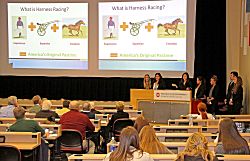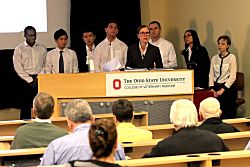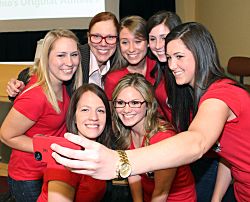Ohio State business students pitch their plans to market harness racing
April 16, 2014,from the USTA Communications Department
Columbus, OH — Horse racing has long sought the best ways to attract new, young fans, especially college students, to the sport and how to get them to come to the racetrack.
Thanks to the Ohio Harness Horsemen’s Association and Dr. Deborah Mitchell’s Ohio State University Project-Based Marketing Consulting course at the Fisher College of Business, harness racing representatives were able to hear some answers directly from the “horse’s mouth” on Wednesday (April 16).

“The Niatross group” makes their presentation.
Eight groups of students, with names like Midland’s Finest, Front Runners and The Mighty Mares, pitched their ideas on how to market harness racing and it wasn’t just a typical end of semester presentation. The setting could have been in the office of any major corporation looking to promote their products or services rather than at the university’s Veterinary Medical Center Auditorium.
The format simulated the agency environment in which the undergraduates had to sell their plan to the client, the OHHA.
“The students were instructed to sell their ideas like they were an agency pitching to a client,” said Dr. Mitchell. “That was to make it as real world as possible and I used my own experience in consulting to coach them.”
And a week from now, after they receive the formal presentation documents from each group, the OHHA will chose their “agency of record.”
The notion to explore harness racing was the idea of OHHA Director and Past President Dr. John Mossbarger from Midland Acres farm.
“I made a phone call and sent a letter to the business college suggesting that a good topic would be how we can market harness racing and make it relevant,” said Dr. Mossbarger. “A couple of months went by before I got a call from Professor Mitchell who told me the class would use harness racing as the project and the OHHA would be the client.”
Dr. Mitchell liked the idea because it was different and relevant to Ohio.

Dr. Mitchell introduces “Midland’s Finest.”
“We have done this with lots of different clients like Scott’s, who sells Miracle-Gro, and with non-profits and government, but never with anything like harness racing,” said Dr. Mitchell in explaining why she decided to use Dr. Mossbarger’s suggestion for her class. “It’s a sport that directly affects Ohioans and it was an opportunity to get a different perspective.”
The OHHA was obviously impressed with the efforts and ideas presented by the Ohio State students.
“They did a lot of research and used focus groups to come up with a marketing plan,” added Dr. Mossbarger. “We got a lot of stuff today, now we have to figure out how to use it.”
There were some universal themes in the presentations. The extensive use of social media for promotion and analytics, creation of a new website, and a new logo and slogan for the organization were the key elements for branding harness racing.
There were dozens of other ideas on how to make the sport more appealing to a broader audience. Some suggestions were like a list of the best practices being utilized at some of the more forward-thinking and most popular racetracks in America now. Things like on-track promotions and giveaways, entertainment between races, better employee customer service training, video ads and promos, and wagering education provided by on-track employees, instructional videos and printed brochures.

USTA/Mark Hall photos
Dr. Mitchell poses with the “Mighty Mares” for a selfie.
Two consistent themes for on-track promotions involved college and family days/nights at the track. Several groups also recommended charity partnerships and community-based events to attract new people to the harness racing experience.
Others called on the OHHA to create a mobile app, advertise on social media platforms and create loyalty programs not so much dependent just on wagering but on participation and engagement.
To specifically target their peers, the students suggested utilizing on-campus, college representatives to spread the word about harness racing to their friends and having the tracks provide free transportation back-and-forth from school to the track.
A few of the groups felt it was important to fund capital expenditures in order to improve the racetrack environment and to upgrade the food and beverage offerings. And one of the long-term goals cited was to attempt to attract new owners through group ownership.
“The students and their presentations were really impressive,” said USTA Director of Marketing and Communications Dan Leary. “But the best part was that we heard all of these ideas from college kids, many who knew nothing about harness racing when they started. They had a fresh perspective, unlike those of us in the industry, who have been trying to figure out what will work in discussions among ourselves.”
According to their professor, it turned into a very special project for her 42 students as well.
“At first their peers thought it was weird doing harness racing,” said Dr. Mitchell. “But this is something they will never forget long after they leave Ohio State. This has become the talk of the Fisher College of Business.”
It will be interesting to see who the OHHA selects. We will let you know.
